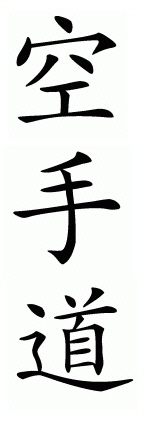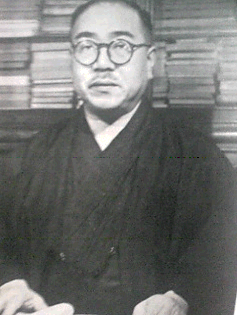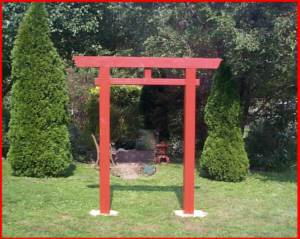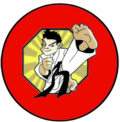| The Isomi House was the birthplace of most Ninjutsu schools and was comprised of 21 different houses. These schools were divided into four main houses, the Shōonai Sanke House (3), the Kashiwagi Sanke House (3) the Kitayama Kuie
House (9) and the Nanzan Rokuie House (6). My house is the Nanzan House under the Wada Iga Lord. This Wada Iga Lord came to Edo in the 18th year of the Tenshōo Era (1591) at the same time as Tokugawa Ieyasu came to Edōo Castle.
At that time Tokugawa’s Shogunal vassal was comprised of 1, 500 koku and gradually he came to rule over 3,500 koku Even today in Kanda, Tōokyōo there is a town called Koga-chou. This is the same area that Kōoga spies seized control of in the 16th century.
The other school, Iga Ryūu, also began in the 18th year of the Tenshōo Era (1591). This is a different subject but there were three major incidents that came to Tokugawa’s attention. At that time there was a temple called Honnōoji that was famous for one of these disturbances. On June 2, 1584, Tokugawa Ieyasu was sightseeing at the border of Senshūu when he heard about the disturbance at Honnōo-ji and decided to return home. However, one of his followers named Nobu began staggering and was unable to return. Tokugawa’s colleagues, Hanzōo Hattori, Sannosuke Tsugi, and Beisetsu Anayama, came to his assistance and lent him the strength of 200 Iga and Kōoga ninjas. They were able to make it back to Mikawa, Ise.
To reward the people of Iga and Kōoga, Tokugawa summoned some of them to Edōo and retained them as spies. In Yotsuya, Edōo there was a town called Iga-chōo. This town was split into Northern and Southern Iga-chōo. The people of Iga-chōo were supervised by a man named Ushizōo Hattori. This is the reason why the people of Iga and Kōoga lived in separate areas of Edōo.
I am the 14th successor of the Wada Iga Spirit and that’s how my house came to protect the traditions of Kōoga. Shiga Prefecture was controlled by Kōoga. In essence, Iga was a part of the Koga District and complied with Kōoga. The neighboring people in the Ayama and Naka Districts of Mie Prefecture further complied with Iga. This area contains the followers of the Fujita house.
The origins of Ninjutsu are extremely ancient. Looking at it from an historical perspective, we turn to Michi no Omi no Mikoto in the age of the Gods.
Iga and Kōoga were surrounded by mountains in every direction. They had many natural defenses. Many military commanders desired to capture them but were unable to successfully do so. (9) Commanders like Nobu Odanaga were at a considerable loss when trying to figure out how to conquer them. In Iga most of the Samurai were called “Chi-samurai”, or land owners, whereas in Kōoga most of them were called “Gōoshi”, or country samurai. These samurai had amassed small fortresses, from 500 tsubo (1655 square meters) to 1,000 tsubo (3,310 square meters) large. They were watching vigilantly for a way to gain more ruling power. Therefore the people living near Iga Harbor had to be aware of spies traveling incognito and develop strategies to limit the likelihood of a surprise attacks. Those going back and forth along the road often resorted to Kamide behavior. Consequently the above mentioned Shōonai House, Kashiwagi House, Kitayama House and Nanzan House became colleagues and often provided mutual aid and assistance to each other. At the same time that they drew up this agreement with each other, they made their alliance known to the entire country.
In the Kamiyo Period at the time when Emperor Jinmu was in control, Michi no Omi no Mikoto took over his turf. After this, he took the name Otomo and joined Kōoga. In other words, we are his descendants. At the time when Prince Shōotoku subjugated the rebels he wanted to know what Hosoiri Otomo’s strategy was for gathering intelligence. According to the record at that time he had originally used the characters from “Maniyōo” to call Otomo “Shinobi” and this marks the beginning of the use of the kanji character
Shinobi. Ninja became the word for Shinobi long after that.
Here are the names of ninja at the time: Tateoka no Mimotsugu?Nomura no
Ootakimagotayuu, Shindōo no Kotarōo?Shimotsuge no Kisaru?Ueno no Hidari?Yamada no Hachiemon?Kōobe no Kominami?Otoba no Kido?Kamiyama no Taroushirōo, etc. These ninja are all men who attained great success.
By way of a memo that has been passed down we can see that each respective family system had its own precepts which were passed down orally from generation to generation. In order to ensure the future prosperity for each family, there were protocols. Those who revealed the secrets of their
systems would without a doubt be assassinated. Those who fell ill agreed to burn any written evidence. Despite this, through my diligent work, I have been able to gather written evidence from 2 of the 50 schools of Ninjutsu.
For each of the respective schools to succeed, there are three conditions that have been determined.
1. When serving a just cause, a warrior will act only in one’s self interest.
2. Concentrate on things that are good for the mind.
3. Learn to act swiftly.
In order to achieve these conditions, there are tests. First fill a basin with water and dip your head up to the neck in the water. Stay underwater for 15 minutes. When you bring your head up out of the water, your technique should be such that you let the water drip off of your hair in a way that if a screen door was laying on its side, the drips would fall without tearing or breaking the paper screen on the door. If the screen breaks or tears, you have failed. To pass this test successfully you will
need to begin to learn how to control your breath.
No matter how fast you run or how dangerous a situation you encounter, there is a way to make sure that you don’t lose your breath or let the expression on your face change. You should be able to control your breath well enough that a piece of paper hanging in front of your nose would not even quiver at your breath. You should be so well disciplined that at the same time you react to a dangerous encounter, you remain as calm and still as someone who has returned from the dead.
As you practice these breathing techniques, also practice the way you walk. There are separate techniques: forwards, sideways, diagonally, backwards, etc. These ways of walking come from 36 methods. There is a way to walk without letting someone hear your footsteps. Even if you jump off of something there is a way to jump without leaving footprints. There is a way to seem as if you are walking forwards when you are walking backwards and a way to walk as if you’re leaving when you are really moving forward. At the same time, if you’re waiting alone, there is an art to imitating the footsteps of 2 or 3 people. Mastering these techniques only comes with extreme training.
There is also the art of speed walking. You should walk fast enough that you can cover 40 “ri” (157.2 km) in one day while maintaining an upright posture to the degree where if a bamboo woven hat was placed on your chest, it would not fall to the ground. There have even been instances where 70 ri (275.1 km) were covered in one day.
There is the art of jumping a distance of 50 shaku (15.15 meters). And with the broad jump you should be able to jump 3 times in succession a distance of 9 shaku (2.73 meters). To practice, take a hemp rope the length of 1 tsubo (3.31 square meters), lay it out on the ground and practice jumping over it day after day. You should repeat this practice for about three years.
There is the art of running. Take a roll of cloth the length of 1 han (10 yards) and attach one end of the cloth to your collar and the stake the other end in the ground. You should practice running the exact length of 10 yards at top speed and be able to stop without letting the cloth slip out of
your collar.
You must also practice the art of jumping into water, underwater respiration and swimming without making a sound.
You must learn to control your tolerance for pain, the movement of your internal organs and the 5 states of the body. There will be times when you will have to go without eating and other times when you will need to be prepared to eat anything and everything. You may have to go without sleep. You will need to learn the art of disguise and be prepared to pose in one of seven guises as a monk, a mountain ascetic, a Zen priest, a practitioner, an acrobat, a merchant, or a commoner. The possibilities are endless, but you should be prepared to any of the seven different forms. The point is to be able to become anyone in any occupation.
You must learn to mimic sounds. You may see or hear something only once before you will need to imitate it immediately. Practice so thoroughly that no matter where you are or what situation you may find yourself in, you are ready.
You will need to practice unlocking doors with whatever tools you may find at your disposal.
Our Ninjutsu Origins
The Kōoga-ryūu method has been a success for over thirteen generations thanks to the efforts of my grandfather. My father originally intended to become a researcher in the medical sciences and so he served as a doctor’s assistant at Sapporo Hospital. He received gradual promotions until he became the director of Shibetoro Hospital. He liked drinking and found that serving as head of a small country hospital did not suit him so he resigned his post and returned to Edōo. He then became a prison guard on Ishikawa Island. He served as a policeman in Asakusa at a small police station in the town of Itsuka-chōo. He continued to be transferred around until he became a
detective thanks to his shrewd investigative techniques. My father focused primarily on murder and theft investigations and during his tenure he aided in catching 8 condemned criminals and 25 others who were sentenced to life imprisonment. He was responsible for over 3,000 arrests during his career.
When I was six years old, I remember my older brother running an errand to the next door neighbor’s house. I saw some boys hit him with a bamboo laundry pole and remember blood streaming from his ear. This really bothered me. I grabbed the sword from our house and ran to help him. I trapped his opponents in the corner of the road and attacked them when I
noticed 11 neighborhood farmers coming towards me to stop me. Since I got in a lot of trouble for this I was sent to be in the custody of the temple.
I stayed at the temple for a little while but there was a devil in the temple and I was really frightened. I wanted to cry out but couldn’t because I thought the devil was playing a trick on me and wouldn’t release me.
Seeing his head caught in the lattice work I could tell that he was ready to snap at me with his teeth. However, neither his eyes nor his nose were moving. I thought, “I’ll get you!” and I moved closer to touch him. All was calm. I touched his shoulder and nothing happened. It was so easy to
be fascinated with him. Then I heard footsteps coming closer. Suddenly I lost my voice and couldn’t scream out. It seemed as if I might faint. I went around behind the devil. I climbed up his back until I was sitting way up on his shoulders. It was difficult for the priests to get me off of his shoulders and I wouldn’t come down. Finally, at the end, I was pulled down and after that I lost all fear. Because of this incident and others when I rang the bell in the temple and smashed a taiko drum, I was thrown out of the temple.
I wanted to return home, but the 11 men were still waiting there and I had no one to help me. At the time, there were a lot of Yamabushi monks residing in the mountains of Chichibu, so I went there.
Ninjutsu is Practice
I studied together there with the monks and it was only afterwards that this knowledge became very useful. The monks would announce arrivals and departures by blowing on a conch shell. They would cook over coals that they lit using the reflection of rays of sunlight. On rainy days, they would start a fire by rubbing two sticks together to make a spark. They would wear one rain clog to help them gain traction on uneven ground as they climbed up the mountains. The monks would carry one live coal in their hand and blow on it to keep the embers burning. When they prepared food, they would boil it in a piece of cloth. As they were ascetic monks, it was not acceptable for them to devour these meals. Each man was allotted a fistful of raw rice. Naturally, those with large hands received a larger quantity of rice and those with small hands, a smaller amount. Those monks of smaller stature who worked hard had larger hands. This was the most natural way to assure that everyone received a just allotment of rice. They would dig up the earth, put a fistful of rice into a cloth, mix the rice with gravel and wash it in the mountain streams. Then, in the same hole that they had made, they would start a fire for cooking and steaming the rice. This fire exemplified the Buddhist symbol of indestructible truth. By following these procedures, the monks were able to meditate and practice the techniques of walking across hot coals and bathing in boiling water. Since then I have practiced these jojutsu 300 hundred times. Plunging one’s hand into boiling water or running it over the blade of a sword serves a hidden purpose. When approaching this from a scientific point of view, this may seem like nothing, but even my daughter can do this.
After several months of practicing jumping or climbing up and down trees, I returned home to discover things. I was 8 years old when I returned to Tōokyōo and I was clairvoyant. At that time I was the sole surviving clairvoyant. Clairvoyance is the art of being able to see through things. They called me a child prodigy and publicized my skills around the world. I was able to work with someone called Kiemon Tatashimaka as well as serve as a divine medium or Shafuku. According to the fortune teller Keizōo, I should practice the art of “seeing” unknown objects that had been placed in boxes or the barrel of a gun. Today there are hardly any remaining Shafuku fortune tellers. Kiemon Tatashimaka said to me, “You really should practice the art of fortune telling.” So I began studying. By reading palms and studying others’ physiques, I became interested in pursuing the study of Budōo arts like Jujistu, Kendōo, Shōogi, Kusarigama, Shuriken, Jitte, etc. I am currently certified in four arts and have been permitted to study the secrets of four others. Eventually it’s possible that I will also concentrate on Kenpōo. I am Nanpo Sato-Ryūu.
Now I would like to talk about the 2nd successor, Iffusai Hashimoto. Hashimoto sensei was an elderly man with a beard, tall enough at 5 shaku (151.5 cm), and thin. He could break the bamboo pipes used for flower arrangement with the tips of his flexible fingers. Even though my fingers
have a diameter of 1 sun (3.03 cm) and are about 1 ishhaku (30 cm) long, if I bind all four fingers together and try to use my whole hand to break one, I still can’t.
With practice, anyone could put their hand in boiling water, or walk barefoot through fire, etc. From the start I recognized that jutsu is not a miracle. The point is practice. It is written that when ninja use Ninjutsu they often make symbolic gestures and chant, but it is not necessary to do
these things yourself.
Here is one way to clear your mind. Join your hands together with the middle finger of your right hand touching the bottom of the pinky of your left hand and try to focus on slowing the beating of your heart. Make sure your breathing is in rhythm with your spirit.
This is a symbol from long ago of the Dojutsu Shingenmippōo. There is a belief that when you cross over water, you should make the gesture for crossing water. When you go through fire, you should make the symbol of the ocean. Only the shape of what we call “9 characters cut” will be left. |







